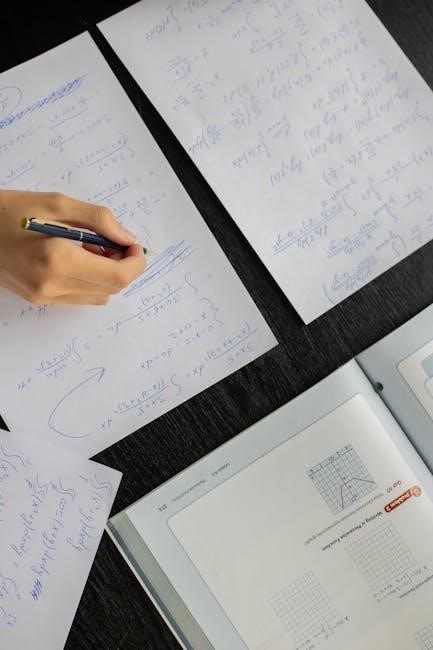Year 11 Standard Maths Textbook PDF: A Comprehensive Guide
Embark on your Year 11 Standard Maths journey with our comprehensive guide to textbook PDFs. We’ll explore various textbook options, resources, and where to find them. This guide will help you unlock your mathematical potential, offering practice questions and exam preparation tips.
Year 11 Standard Maths serves as a crucial stepping stone in your mathematical education, bridging the gap between foundational concepts and more advanced applications. This course is designed to equip students with practical mathematical skills applicable to everyday life and various career paths. The curriculum emphasizes problem-solving, critical thinking, and the ability to model real-world scenarios using mathematical tools.
Unlike its more theoretical counterparts, Standard Maths focuses on relevance and applicability. You’ll explore topics like financial mathematics, measurement, statistical analysis, and spatial reasoning, all presented within a context that highlights their practical use. Success in this course requires not only understanding mathematical concepts but also the ability to apply them effectively to solve problems.
Textbooks play a vital role in your learning journey, providing structured content, worked examples, and practice questions. They serve as a comprehensive resource for understanding the syllabus requirements and developing the necessary skills for success. Finding the right textbook, whether in print or PDF format, is essential for effective learning and exam preparation. This guide aims to assist you in navigating the world of Year 11 Standard Maths textbooks and resources.
Key Topics Covered in Year 11 Standard Maths
Year 11 Standard Maths encompasses a variety of essential topics designed to enhance your mathematical proficiency and prepare you for real-world applications. A core area involves financial mathematics, where you’ll learn about budgeting, loans, investments, and understanding financial statements. This knowledge is invaluable for managing personal finances and making informed economic decisions.
Measurement is another significant component, covering topics like area, volume, and rates. You’ll develop skills in converting units, calculating dimensions, and applying these concepts to practical situations. Statistical analysis introduces you to data collection, representation, and interpretation. You’ll learn to analyze data sets, identify trends, and make predictions based on statistical evidence.
Spatial reasoning explores geometry and trigonometry, focusing on shapes, angles, and their relationships. This includes understanding maps, scale drawings, and applying geometric principles to solve problems involving spatial arrangements. Additionally, the course often includes networks, which involves understanding and analyzing network diagrams, such as those used in transportation or communication systems.
These key topics are interwoven to provide a well-rounded mathematical education, emphasizing practical skills and problem-solving abilities relevant to various aspects of life.
Textbook Options: A Comparative Overview

Choosing the right textbook for Year 11 Standard Maths is crucial for academic success. Several options are available, each with unique features and benefits. CambridgeMATHS Stage 6 Mathematics Standard Year 11, powered by Cambridge HOTmaths, combines a proven teaching and learning formula with interactive resources, offering logical topic development and graded questions.
Mathematics for Australia 11 General Mathematics is designed specifically for the Australian Curriculum, addressing the content outlined in the ACARA General Mathematics curriculum. It provides activities and solutions focused on ClassPad technology, enhancing practical application.
Pearson Australia offers leading teaching resources in both online and print formats. Their Year 11 General Mathematics student books focus explicitly on the Australian Curriculum, with well-developed chapters that support content mastery.

When comparing these options, consider factors such as alignment with the curriculum, availability of interactive resources, the clarity of explanations, and the quantity and quality of practice questions. Some textbooks may offer additional support materials like syllabus maps, teaching programs, and sample exams.
Ultimately, the best textbook will depend on your individual learning style and the specific requirements of your school or teacher. Evaluating sample pages and reviews can help you make an informed decision.
CambridgeMATHS Stage 6 Mathematics Standard Year 11
CambridgeMATHS Stage 6 Mathematics Standard Year 11 is a comprehensive resource designed to support students in their Year 11 mathematics studies. This interactive textbook, powered by Cambridge HOTmaths, combines proven teaching and learning approaches with a user-friendly digital platform.
Key features of CambridgeMATHS include logical and manageable topic development, ensuring students can grasp concepts step-by-step. The textbook also offers graded questions, allowing students to build confidence and progressively tackle more challenging problems. A large number of fully worked examples demonstrate mathematical processes and encourage independent learning.
The interactive component, Cambridge HOTmaths, provides students with access to a wealth of digital resources, including videos, interactive simulations, and assessment tools. This helps to cater for different learning styles and provides opportunities for personalized learning.
While the print version offers a traditional textbook experience, the interactive version enhances engagement and provides immediate feedback. Both formats aim to equip students with the necessary skills and knowledge to succeed in their Year 11 Mathematics Standard course.
It’s important to note that availability may vary, so checking with your local customer service is recommended to confirm access to this valuable resource.
Mathematics for Australia 11 General Mathematics
Mathematics for Australia 11 General Mathematics is specifically designed for the Australian Curriculum, addressing the content outlined in the ACARA General Mathematics (or WACE Mathematics Applications) Curriculum Units 1 and 2, as well as the Sāmoa Ministry of Education and Culture requirements. This textbook aims to facilitate learning through a series of activities focused on both mathematical concepts and technology integration.
The book includes a range of activities designed to enhance understanding and skill development. It particularly emphasizes the use of ClassPad technology, providing students with opportunities to explore mathematical concepts in a dynamic and interactive way. A downloadable PDF is available with 29 activities and solutions, offering ample practice and reinforcement.
It focuses explicitly on development of content addressing the Australian Curriculum, ensuring alignment with national standards. The chapters are well-structured, presenting information in a clear and accessible manner. The textbook also incorporates real-world applications of mathematics, helping students to see the relevance of their studies.
Designed and written for the Australian Curriculum, it addresses the content in the ACARA General Mathematics curriculum. The textbook is a valuable resource for students seeking a comprehensive and curriculum-aligned approach to Year 11 General Mathematics.
Pearson Australia’s Year 11 Maths Resources
Unlock the potential of your classroom with Pearson Australia’s leading teaching resources designed for Australia & NZ, available in both online and print formats. Discover a world of innovation and excellence in education with resources tailored to meet the needs of Year 11 students. Pearson provides a comprehensive suite of materials designed to support both teachers and students in mastering the Year 11 Maths curriculum.
These resources focus explicitly on the development of content addressing the Australian Curriculum, ensuring that students are well-prepared for their exams and future studies. The chapters are well-structured and easy to follow, making it simple for students to grasp key concepts and build a strong foundation in mathematics. The resources are designed to be engaging and interactive, helping to keep students motivated and interested in learning.
Pearson Australia’s resources offer a range of features, including practice questions, worked examples, and assessment tools. These features are designed to help students develop their problem-solving skills and build confidence in their abilities. For teachers, Pearson provides a range of support materials, including lesson plans, assessment rubrics, and professional development opportunities.
With a commitment to innovation and excellence, Pearson Australia provides a valuable suite of resources designed to support success in Year 11 Maths.
Free Maths Textbooks for Year 11
Accessing quality educational resources doesn’t always require a hefty price tag. Fortunately, there’s a growing availability of free maths textbooks suitable for Year 11 students. These resources can be invaluable for students seeking extra practice, alternative explanations, or simply a cost-effective way to supplement their learning.
A great collection of free textbooks for mathematics exists, catering to all grades, including Year 11. Practice is key to mastering mathematical concepts, and these free resources offer ample opportunities for students to hone their skills. Keep in mind that some free resources may be excerpts, samples, or older editions. While content might be similar, ensure alignment with the current curriculum.
While exploring free options, consider resources provided by educational organizations, government initiatives, or open-source projects. Be diligent in evaluating the credibility and accuracy of any free textbook before relying on it for serious study. Scrutinize the content for errors and compare it with other trusted sources or your school textbook.
By utilizing free maths textbooks strategically, Year 11 students can enhance their learning experience without incurring significant costs. Remember to prioritize quality and alignment with the curriculum for optimal results. These resources provide additional support, practice, and a different perspective on mathematical concepts.
Year 11 Mathematics Advanced Course Coverage
The Year 11 Mathematics Advanced course builds upon foundational mathematical concepts, introducing more complex topics that require a deeper understanding. Textbooks designed for this course aim to provide comprehensive coverage of the syllabus, ensuring students are well-prepared for assessments and future studies.
Typically, a Year 11 Mathematics Advanced textbook will delve into topics such as advanced algebra, trigonometry, calculus, and coordinate geometry. Advanced algebra might include polynomial functions, inequalities, and logarithms. Trigonometry expands on basic trigonometric ratios, exploring trigonometric identities and equations. Calculus introduces the concepts of differentiation and integration, laying the groundwork for further study.
Coordinate geometry involves studying geometric shapes using algebraic methods. The theory within these textbooks follows a logical order, although some topics may be learned in any order. Each chapter presents the material in a clear and concise manner, with numerous examples and practice exercises to reinforce understanding.
Furthermore, textbooks often include problem-solving strategies and real-world applications to demonstrate the relevance of mathematical concepts. These resources also provide opportunities for students to develop their mathematical reasoning and critical-thinking skills, essential for success in the advanced course.
By thoroughly covering the syllabus and providing ample practice, Year 11 Mathematics Advanced textbooks empower students to excel in their studies.
Practice Questions and Problem-Solving Tasks
Mastering Year 11 Standard Maths requires consistent practice and the ability to apply learned concepts to solve problems effectively. Textbooks play a crucial role in this process by providing a wealth of practice questions and problem-solving tasks designed to reinforce understanding and build confidence.
These practice questions typically range in difficulty, starting with basic exercises to solidify fundamental skills and progressing to more challenging problems that require critical thinking and application of multiple concepts. Problem-solving tasks often involve real-world scenarios, encouraging students to see the relevance of mathematics in everyday life.
A good textbook will include a variety of question types, such as multiple-choice, short answer, and extended response, to prepare students for different assessment formats. Fully worked examples are essential, demonstrating the step-by-step process of solving problems and providing guidance for students who may be struggling.
Furthermore, textbooks often include problem-solving strategies and tips to help students approach unfamiliar problems with confidence. Additional resources like syllabus maps, sample exams, and banks of questions provide extra practice opportunities.
Regularly engaging with practice questions and problem-solving tasks is key to success in Year 11 Standard Maths, allowing students to develop their skills, identify areas for improvement, and build a strong foundation for future studies.
Where to Find Year 11 Maths Textbook PDFs
Finding the right Year 11 Maths textbook in PDF format can significantly aid your studies. Several avenues offer access to these digital resources, each with its own advantages.
Firstly, check with your school or educational institution. Many schools now provide digital textbooks or access to online platforms where textbook PDFs can be downloaded. These resources are often tailored to the specific curriculum being taught.
Secondly, explore the websites of major textbook publishers like Cambridge University Press, Pearson Australia, and Oxford University Press. They often offer sample chapters or even full textbook PDFs for download as part of their promotional material or educational resources.

Thirdly, online educational platforms and repositories can be valuable sources; Websites dedicated to educational resources may host free or low-cost textbook PDFs. However, ensure the legitimacy and quality of the source before downloading to avoid copyright issues or inaccurate content.
Fourthly, consider online libraries and digital archives. Some libraries offer digital lending services, allowing you to borrow textbook PDFs for a limited time. Websites dedicated to preserving and sharing educational materials may also contain relevant resources.
Finally, remember to utilize search engines effectively. Use specific keywords like “Year 11 Maths textbook PDF” along with the name of a particular textbook or publisher to narrow down your search. Always prioritize reputable sources and be mindful of copyright restrictions.
Utilizing Textbooks for Exam Preparation
Textbooks are invaluable tools for Year 11 Maths exam preparation, offering a structured approach to mastering concepts and honing problem-solving skills. To effectively utilize textbooks, begin by creating a study schedule that aligns with the exam syllabus.
Start with a thorough review of each chapter, focusing on key definitions, theorems, and formulas. Work through the examples provided in the textbook, paying close attention to the step-by-step solutions. This will help you understand the application of concepts and develop your problem-solving techniques.

Next, tackle the practice questions at the end of each chapter. Begin with the easier questions to build confidence and gradually progress to more challenging problems. If you encounter difficulties, revisit the relevant sections of the textbook or seek assistance from your teacher or classmates.
Pay close attention to any problem-solving strategies or tips provided in the textbook. These insights can be invaluable for tackling complex exam questions. Additionally, review past exam papers and use the textbook to identify areas where you need to improve.
Create a formula sheet or summary of key concepts from the textbook. This will serve as a quick reference guide during your revision process. Finally, practice time management by simulating exam conditions and working through practice papers within the allocated time limit. Regular practice and consistent effort are key to success.
